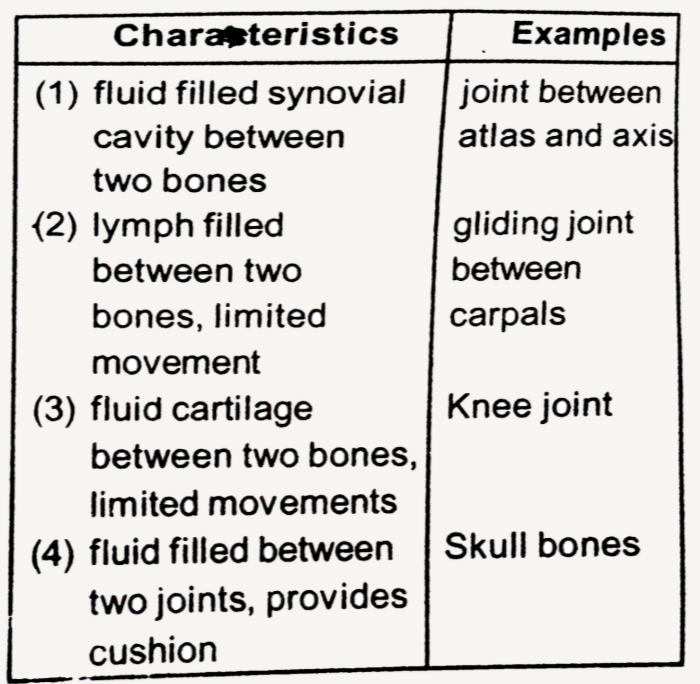Fixed joint and synovial joint
Step-by-Step Text Solution:
Step 1: Definition of Fixed Joint
- A fixed joint, also known as an immovable joint, is a type of joint where the bones do not move or bend.
Step 2: Characteristics of Fixed Joints
- These joints are characterized by their inability to allow any movement between the connected bones.
Step 3: Examples of Fixed Joints
- Common examples of fixed joints include:
- The bones of the skull (which protect the brain)
- The teeth in their sockets within the jaw
Step 4: Definition of Synovial Joint
- A synovial joint is a type of joint that allows for movement and bending of the bones.
Step 5: Characteristics of Synovial Joints
- Synovial joints consist of a cavity lined with cartilage and are filled with synovial fluid, which lubricates the joint and facilitates smooth movement.
Step 6: Types of Synovial Joints
- There are several types of synovial joints, including:
- Planar joints (allow sliding movements)
- Hinge joints (allow bending in one direction)
- Saddle joints (allow movement in two different planes)
- Condyloid joints (allow movement but not rotation)
- Ball and socket joints (allow for the greatest range of motion)
- A fixed joint, also known as an immovable joint, is a type of joint where the bones do not move or bend.
- These joints are characterized by their inability to allow any movement between the connected bones.
- Common examples of fixed joints include:
- The bones of the skull (which protect the brain)
- The teeth in their sockets within the jaw
- A synovial joint is a type of joint that allows for movement and bending of the bones.
- Synovial joints consist of a cavity lined with cartilage and are filled with synovial fluid, which lubricates the joint and facilitates smooth movement.
- There are several types of synovial joints, including:
- Planar joints (allow sliding movements)
- Hinge joints (allow bending in one direction)
- Saddle joints (allow movement in two different planes)
- Condyloid joints (allow movement but not rotation)
- Ball and socket joints (allow for the greatest range of motion)
Topper's Solved these Questions
- LOCOMOTIONA ND MOVEMENT BOOK - ICSECHAPTER - LOCOMOTIONA ND MOVEMENT EXERCISE - NCERT EXERCISES WITH ANSWER (Fill in the blanks )
6 Videos
- LOCOMOTION AND MOVEMENTBOOK - ICSECHAPTER - LOCOMOTION AND MOVEMENTEXERCISE - LONG ANSWER TYPE QUESTIONS
14 Videos
- MINERAL NUTRITION BOOK - ICSECHAPTER - MINERAL NUTRITION EXERCISE - NCERT EXERCISE WITH ANSWER (DIFFERNTIATE BETWEEN )
9 Videos
Similar Questions
Cartilaginous joints and Synovial joints
View SolutionExplain: Fibrous joints and Synovial joints
View SolutionExplain a synovial joint.
View SolutionWhich one of the following is not a synovial joint
View Solution_____acts as a lubricant in a synovial joint.
View SolutionAssertion : Maximum movement is possible at the amphiarthrosis joint.
Reason : Such joint are also called synovial joints and have almost frictionless movement due to synovial fluid.
View SolutionThe characteristics and an example of a synovial joint in humans is :

View SolutionThe characteristics and an example of a synovial joint in humans is

View SolutionGive an example for each of the following:
A synovial joint
View SolutionAssertion : Maximum movement is possible at the amphiarthrosis joint.
Reason : Such joint are also called synovial joints and have almost frictionless movement due to synovial fluid.
(a) If both Assertion and Reason are true and the Reason is the correct explanation of the Assertion.
(b (b) If both Assertion and Reason are true, but the Reason is not the correct explanation of the Assertion.
(c) If Assertion is true, but Reason is false .
(d) If both Assertion and Reason are false.
View Solution
